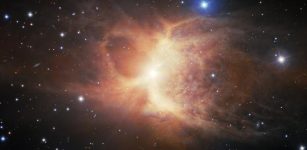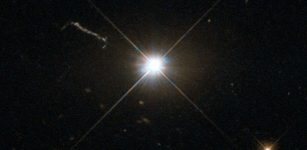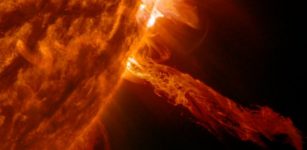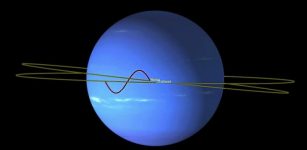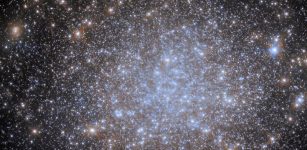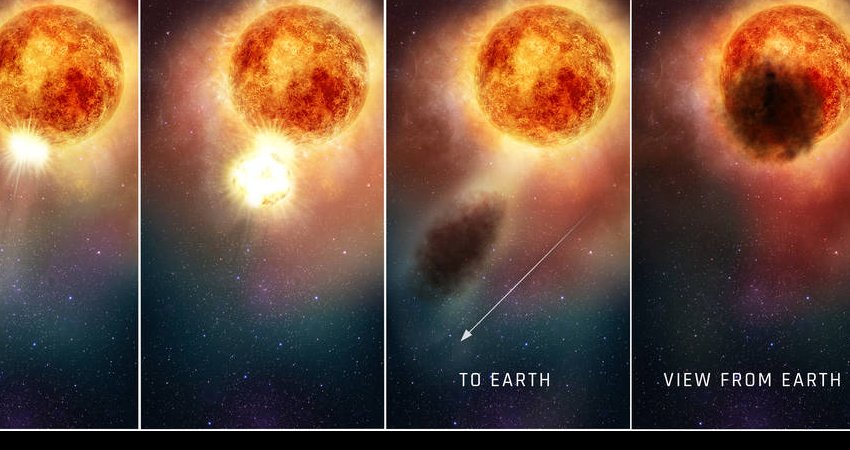Properties Of Mercury, Venus, Earth And Mars Explained By Cosmic History
Eddie Gonzales Jr. – MessageToEagle.com – Astronomers have managed to link the properties of the inner planets of our solar system with our cosmic history: with the emergence of ring structures in the swirling disk of gas and dust in which these planets were formed.
The rings are associated with basic physical properties such as the transition from an outer region where ice can form where water can only exist as water vapor. The astronomers made use of a spread of simulation to explore different possibilities of inner planet evolution.
This is the sharpest image ever taken by ALMA — sharper than is routinely achieved in visible light with the NASA/ESA Hubble Space Telescope. It shows the protoplanetary disc surrounding the young star HL Tauri. These new ALMA observations reveal substructures within the disc that have never been seen before and even show the possible positions of planets forming in the dark patches within the system. Credit: ALMA (ESO/NAOJ/NRAO)
Our solar system’s inner regions are a rare, but possible outcome of that evolution.
The broad-stroke picture of planet formation around stars has been unchanged for decades. But many of the specifics are still unexplained—and the search for explanations an important part of current research. Now, a group of astronomers led by Rice University’s Andre Izidoro, which includes Bertram Bitsch from the Max Planck Institute for Astronomy, has found an explanation for why the inner planets in our solar system have the properties we observe.
A swirling disk and rings that change everything
The broad-stroke picture in question is as follows: Around a young star, a “protoplanetary disk” of gas and dust forms, and inside that disk grow ever-larger small bodies, eventually reaching diameters of thousands of kilometers, that is: becoming planets. But in recent years, thanks to modern observational methods, the modern picture of planet formation has been refined and changed in very specific directions.
The most striking change was triggered by a literal picture: The first image taken by the ALMA observation after its completion in 2014. The image showed the protoplanetary disk around the young star HL Tauri in unprecedented detail, and the most stunning details amounted to a nested structure of clearly visible rings and gaps in that disk.
As the researchers involved in simulating protoplanetary disk structures took in these new observations, it became clear that such rings and gaps are commonly associated with “pressure bumps,” where the local pressure is somewhat lower than in the surrounding regions. Those localized changes are typically associated with changes in disk composition, mostly in the size of dust grains.
Three key transitions that produce three rings
In particular, there are pressure bumps associated with particularly important transitions in the disk that can be linked directly to fundamental physics. Very close to the star, at temperatures higher than 1400 Kelvin, silicate compounds (think “sand grains”) are gaseous—it is simply too hot for them to exist in any other state. Of course, that means that planets cannot form in such a hot region. Below that temperature, silicate compounds “sublimate,” that is, any silicate gases directly transition to a solid state. This pressure bump defines an overall inner border for planet formation.
Farther out, at 170 Kelvin (-100 degrees Celsius), there is a transition between water vapor on the one hand and water ice on the other hand, known as the water snowline. (The reason that temperature is so much lower than the standard 0 degrees Celsius where water freezes on Earth is the much lower pressure, compared to Earth’s atmosphere.) At even lower temperatures, 30 Kelvin (-240 degrees Celsius), is the CO snowline; below that temperature, carbon monoxide forms a solid ice.
Pressure bumps as pebble traps
What does this mean for the formation of planetary systems? Numerous earlier simulations had already shown how such pressure bumps facilitate the formation of planetesimals—the small objects, between 10 and 100 kilometers in diameter, that are believed to be the building blocks for planets. After all, the formation process starts much, much smaller, namely with dust grains. Those dust grains tend to collect in the low-pressure region of a pressure bump, as grains of a certain size drift inwards (that is, towards the star) until they are stopped by the higher pressure at the inner boundary of the bump.
As the grain concentration at the pressure bump increases, and in particular the ratio of solid material (which tends to aggregate) to gas (which tends to push grains apart) increases, it becomes easier for those grains to form pebbles, and for those pebbles to aggregate into larger objects. Pebbles are what astronomers call solid aggregates with sizes between a few millimeters and a few centimeters.
The role of pressure bumps for the (inner) solar system
But what had still be an open question was the role of those sub-structures in the overall shape of planetary systems, like our own Solar system, with its characteristic distribution of rocky, terrestrial inner planets and outer gaseous planets. This is the question that Andre Izidoro (Rice University), Bertram Bitsch of the Max Planck Institute for Astronomy and their colleagues took on. In their search for answers, they combined several simulations covering different aspects and different phases of planet formation.
Specifically, the astronomers constructed a model of a gas disk, with three pressure bumps at the silicates-become-gaseous boundary and the water and CO snow lines. They then simulated the way that dust grains grow and fragment in the gas disk, the formation of planetesimals, the growth from planetesimals to planetary embryos (from 100 km in diameter to 2000 km) near the location of our Earth (“1 astronomical unit” distance from the sun), the growth of planetary embryos to planets for the terrestrial planets, and the accumulation of planetesimals in a newly-formed asteroid belt.
In our own solar system, the asteroid belt between the orbits of Mars and Jupiter is home to hundreds of smaller bodies, which are believed to be remnants or collision fragments of planetesimals in that region that never grew to form planetary embryos, let alone planets.
Variations on a planetary theme
An interesting question for simulations is this: If the initial setup were just a little bit different, would the end result still be somewhat similar? Understanding these kinds of variations is important for understanding which of the ingredients are the key to the outcome of the simulation. That is why Bitsch and his colleagues analyzed a number of different scenarios with varying properties for the composition and for the temperature profile of the disk. In some of the simulations, they only the silicate and water ice pressure bumps, in others all three.
The results suggest a direct link between the appearance of our solar system and the ring structure of its protoplanetary disk. Bertram Bitsch of the Max Planck Institute for Astronomy, who was involved both in planning this research program and in developing some of the methods that were used, says: “For me, it was a complete surprise how well our models were able to capture the development of a planetary system like our own—right down to the slightly different masses and chemical compositions of Venus, Earth and Mars.”
As expected, in those models, planetesimals in those simulations formed naturally near the pressure bumps, as a “cosmic traffic jam” for pebbles drifting inwards, which would then be stopped by the higher pressure at the inner boundary of the pressure bump.
Recipe for our (inner) solar system
For the inner parts of the simulated systems, the researchers identified the right conditions for the formation of something like our own solar system: If the region right outside the innermost (silicate) pressure bump contains around 2.5 Earth masses’ worth of planetesimals, these grow to form roughly Mars-sized bodies—consistent with the inner planets within the solar system.
A more massive disk, or else a higher efficiency of forming planetesimals, would instead lead to the formation of “super-Earths,” that is, considerably more massive rocky planets. Those super-Earths would be in close orbit around the host star, right up against that innermost pressure bump boundary. The existence of that boundary can also explain why there is no planet closer to the sun than Mercury—the necessary material would simply have evaporated that close to the star.
The simulations even go so far as to explain the slightly different chemical compositions of Mars on the one hand, Earth and Venus on the other: In the models, Earth and Venus indeed collect most of the material that will form their bulk from regions closer to the sun than the Earth’s current orbit (one astronomical unit). The Mars-analogs in the simulations, in contrast, were built mostly from material from regions a bit farther away from the sun.
How to build an asteroid belt
Beyond the orbit of Mars, the simulations yielded a region that started out as sparsely populated with or, in some cases, even completely empty of planetesimals—the precursor of the present-day asteroid belt of our solar systems. However, some planetesimals from the zones inside of or directly beyond would later stray into the asteroid belt region and become trapped.
As those planetesimals collided, the resulting smaller pieces would form what we today observe as asteroids. The simulations are even able to explain the different asteroid populations: What astronomers call S-types asteroids, bodies that are made mostly of silica, would be the remnants of stray objects originating in the region around Mars, while C-type asteroids, which predominantly contain Carbon, would be the remnants of stray objects from the region directly outside the asteroid belt.
Outer planets and Kuiper belt
In that outer region, just outside the pressure bump that marks the inner limit for the presence of water ice, the simulations show the beginning of the formations of giant planets—the planetesimals near that boundary typically have a total mass of between 40 and 100 times the mass of the Earth, consistent with estimates of the total mass of the cores of the giant planets in our solar system: Jupiter, Saturn, Uranus and Neptune.
In that situation, the most massive planetesimals would quickly gather more mass. The present simulations did not follow up on the (already well-studied) later evolution of those giant planets, which involves an initially rather tight group, from which Uranus and Neptune later migrated outwards to their present positions.
Last but not least, the simulations can explain the final class of objects, and its properties: so-called Kuiper-belt objects, which formed outside the outermost pressure bump, which marks the inner boundary for the existence of carbon monoxide ice. It even can explain the slight differences in composition between known Kuiper-belt objects: again as the difference between planetesimals that formed originally outside the CO snowline pressure bump and stayed there, and planetesimals that strayed into the Kuiper belt from the adjacent inner region of the giant planets.
Two basic outcomes and our rare solar system
Overall, the spread of simulations led to two basic outcomes: Either a pressure bump at the water-ice snowline formed very early; in that case, the inner and outer regions of the planetary system went their separate ways rather early on within the first hundred thousand years. This led to the formation of low-mass terrestrial planets in the inner parts of the system, similar to what happened in our own solar system.
Alternatively, if the water-ice pressure bump forms later than that or is not as pronounced, more mass can drift into the inner region, leading instead to the formation of super-Earths or mini-Neptunes in the inner planetary systems. Evidence from the observations of those exoplanetary systems astronomers have found so far shows that case is by far the more probable—and our own Solar system a comparatively rare outcome of planet formation.
Outlook
In this research, the focus of the astronomers was on the inner solar system and the terrestrial planets. Next, they want to run simulations that include details of the outer regions, with Jupiter, Saturn, Uranus and Neptune. The eventual aim is to arrive at a complete explanation for the properties of ours and other solar systems.
For the inner solar system, at least, we now know that key properties of Earth and its nearest neighboring planet can be traced to some rather basic physics: the boundary between frozen water and water vapor and its associated pressure bump in the swirling disk of gas and dust that surrounded the young sun.
Paper
A. Izidoro et al., “Planetesimal rings as the cause of the Solar System’s planetary architecture” in the journal Nature Astronomy.
Written by Eddie Gonzales Jr. – MessageToEagle.com Staf


